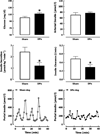Relationship between beta-cell mass and diabetes onset
- PMID: 18834430
- PMCID: PMC3375862
- DOI: 10.1111/j.1463-1326.2008.00939.x
Relationship between beta-cell mass and diabetes onset
Abstract
Regulation of blood glucose concentrations requires an adequate number of beta-cells that respond appropriately to blood glucose levels. beta-Cell mass cannot yet be measured in humans in vivo, necessitating autopsy studies, although both pre- and postmorbid changes may confound this approach. Autopsy studies report deficits in beta-cell mass ranging from 0 to 65% in type 2 diabetes (T2DM), and approximately 70-100% in type 1 diabetes (T1DM), and, when evaluated, increased beta-cell apoptosis in both T1DM and T2DM. A deficit of beta-cell mass of approximately 50% in animal studies leads to impaired insulin secretion (when evaluated directly in the portal vein) and induction of insulin resistance. We postulate three phases for diabetes progression. Phase 1: selective beta-cell cytotoxicity (autoimmune in T1DM, unknown in T2DM) leading to impaired beta-cell function and gradual loss of beta-cell mass through apoptosis. Phase 2: decompensation of glucose control when the pattern of portal vein insulin secretion is sufficiently impaired to cause hepatic insulin resistance. Phase 3: adverse consequences of glucose toxicity accelerate beta-cell dysfunction and insulin resistance. The relative contribution of beta-cell loss versus beta-cell dysfunction to diabetes onset remains an area of controversy. However, because cytotoxicity sufficient to induce beta-cell apoptosis predictably disturbs beta-cell function, it is naive to attempt to distinguish the relative contributions of these linked processes to diabetes onset.
Conflict of interest statement
The authors declare no conflict of interest.
Figures



References
-
- Meier JJ, Butler PC. Insulin secretion. In: DeGroot LJJJ, editor. Endocrinology. 5 edn. Philadelphia: Elsevier Saunders; 2005. pp. 961–973.
-
- DeFronzo RA. Lilly lecture 1987. The triumvirate: beta-cell, muscle, liver. A collusion responsible for NIDDM. Diabetes. 1988;37:667–687. - PubMed
-
- Kloppel G, Lohr M, Habich K, Oberholzer M, Heitz PU. Islet pathology and the pathogenesis of type 1 and type 2 diabetes mellitus revisited. Surv Synth Pathol Res. 1985;4:110–125. - PubMed
-
- Butler AE, Janson J, Bonner-Weir S, Ritzel R, Rizza RA, Butler PC. Beta-cell deficit and increased beta-cell apoptosis in humans with type 2 diabetes. Diabetes. 2003;52:102–110. - PubMed
-
- Yoon KH, Ko SH, Cho JH, et al. Selective beta-cell loss and alpha-cell expansion in patients with type 2 diabetes mellitus in Korea. J Clin Endocrinol Metab. 2003;88:2300–2308. - PubMed
Publication types
MeSH terms
Substances
Grants and funding
LinkOut - more resources
Full Text Sources
Other Literature Sources
Medical

